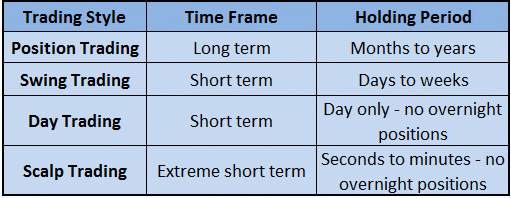The trading strategies differ depending on the holding time. Choosing the ideal system is challenging for fresh traders, making it vital for sustainable profitability. You should know that there is no one-size-fits-all strategy to get the best out of your experience.

Overview of trading styles
Selecting the perfect style of trading will help you scale your profits while optimizing your trade options. Knowing your options in this business requires a deep commitment to learning and knowing which style best suits you depending on your goals. Here is a breakdown of the distinct strategies of trading.

Swing trading
This involves traders holding for a day at the least and this may extend for several days or weeks. The beauty is that the trader does not have to sit and watch daily. This strategy gets used among people who have to attend to other activities and can’t focus on their trades. It does not mean that the trader can leave his or her trading chair as they will still have to watch the markets.
Scalping
Here the trader keeps the positions active for minutes. Scalp trading emphasizes minute price movements for trades within the day. This style stands on the ideology of getting as many trades done with little profits within a short time. Doing this leads to a gradual build-up of profits during the day because of the trade volume.
The idea behind dealing in major currencies alone depends on the fact that they get traded more and have high liquidity. Scalp traders focus their trades on the busiest part of the day when the volume of trade is more with increased volatility. The focus of scalp traders is to get the tightest available spread.
Attempting to scalp some profit during frequent trade during the day is something that can be challenging and time-taking. Focusing on the indices for hours at a stretch can be a hard task. Owing to the intensity of scalping, scalp traders often trade in pairs. Scalp traders don’t have an ideal system of trading; hence they resort to this system and as such, it is not advisable that you use it.
Day Trading
It may not be a trader’s favorite but traders who do not want to keep positions for extended periods can opt for day trading. Traders here get the deals done on the same day, thus mitigating the risks of making wrong moves overnight.
Each day starts and ends with a loss or gain depending on how profitable the moves were. In this strategy, you may be at it for hours or minutes and need enough time to track trades and analyze the market all through the day. This strategy means that the trader depends on minute gains built up during the day.
Position trading
In this system, there is a need to hold a position in a security for a long time. Price movements within a short time do not influence the decisions of traders as they instead focus on long-term gains. This strategy has some semblance to investing and it is the one with the longest period among the trading styles. Position trading has some unique benefits. These benefits include the ability to leverage more prominent trends while avoiding market noise. It also has less need to maintain positions.
Final word
Each trading style comes with its unique perks and understanding how they work helps the trader maximize his or her trade. Intraday traders spend hours on trading while scalpers do it in minutes. Swing traders use up to six days while position traders do it in a few weeks.








Leave a Reply